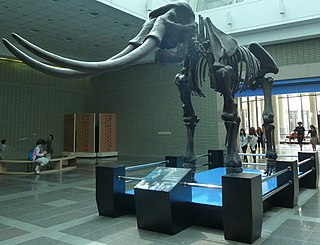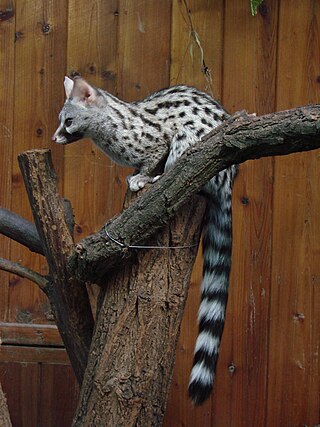The Pliocene is the epoch in the geologic time scale that extends from 5.333 million to 2.58 million years ago. It is the second and most recent epoch of the Neogene Period in the Cenozoic Era. The Pliocene follows the Miocene Epoch and is followed by the Pleistocene Epoch. Prior to the 2009 revision of the geologic time scale, which placed the four most recent major glaciations entirely within the Pleistocene, the Pliocene also included the Gelasian Stage, which lasted from 2.588 to 1.806 million years ago, and is now included in the Pleistocene.

Palaeoloxodon is an extinct genus of elephant. The genus originated in Africa during the Pliocene, and expanded into Eurasia during the Pleistocene. The genus contains some of the largest known species of elephants, over 4 metres (13 ft) tall at the shoulders, including the African Palaeoloxodon recki, the European straight-tusked elephant and the South Asian Palaeoloxodon namadicus. P. namadicus has been suggested to be the largest known land mammal by some authors based on extrapolation from fragmentary remains, though these estimates are highly speculative. In contrast, the genus also contains many species of dwarf elephants that evolved via insular dwarfism on islands in the Mediterranean, some only 1 metre (3.3 ft) in height, making them the smallest elephants known. The genus has a long and complex taxonomic history, and at various times, it has been considered to belong to Loxodonta or Elephas, but today is usually considered a valid and separate genus in its own right.

Dwarf elephants are prehistoric members of the order Proboscidea which, through the process of allopatric speciation on islands, evolved much smaller body sizes in comparison with their immediate ancestors. Dwarf elephants are an example of insular dwarfism, the phenomenon whereby large terrestrial vertebrates that colonize islands evolve dwarf forms, a phenomenon attributed to adaptation to resource-poor environments and lack of predation and competition. Some modern populations of Asian elephants have also undergone size reduction on islands to a lesser degree, resulting in populations of pygmy elephants.

Myotragus is an extinct genus of goat-antelope in the tribe Caprini which lived on the Balearic Islands of Mallorca and Menorca in the western Mediterranean until its extinction around 4,500 years ago. The fossil record of Myotragus on the Balearic Islands extends over 5 million years back to the early Pliocene on Mallorca, where it presumably arrived after the evaporation of the Mediterranean Sea during the Messinian Salinity Crisis.

A genet is a member of the genus Genetta, which consists of 17 species of small African carnivorans. The common genet is the only genet present in Europe and occurs in the Iberian Peninsula, Italy and France.

The crested servaline genet, also known as the crested genet, is a genet species endemic to Nigeria and Cameroon. As the population has declined due to loss of habitat, it is listed as Vulnerable on the IUCN Red List. It was first recorded in the Mamfe Division in Cameroon and initially considered a subspecies of the servaline genet. But now it is regarded as a distinct species.

The servaline genet is a genet species native to Central Africa. As it is widely distributed and considered common, it is listed as Least Concern on the IUCN Red List.

The Angolan genet or miombo genet is a genet species endemic to Southern Africa. It is considered common in this region and therefore listed as Least Concern in the IUCN Red List. Little is known about its ecology.

The common genet is a small viverrid indigenous to Africa that was introduced to southwestern Europe. It is widely distributed north of the Sahara, in savanna zones south of the Sahara to southern Africa and along the coast of Arabia, Yemen and Oman. It is listed as Least Concern on the IUCN Red List.

The giant forest genet, also known as the giant genet, is a genet species endemic to the Congo Basin. As it is considered as widely distributed and common, it is listed as Least Concern on the IUCN Red List.
The Cypriot mouse is a species of mouse endemic to Cyprus. Its primary habitat seems to be the vineyards and fields of the Troödos Mountains region.

The Cape genet, also known as the South African large-spotted genet, is a genet species endemic to South Africa. As it is common and not threatened, it is listed as Least Concern on the IUCN Red List. Like other genets, it is nocturnal and arboreal, preferring to live in the riparian zones of forests, as long as these are not marshy areas.

The Cyprus dwarf hippopotamus or Cypriot pygmy hippopotamus is an extinct species of hippopotamus that inhabited the island of Cyprus from the Pleistocene until the early Holocene. The 200-kilogram (440 lb) Cyprus dwarf hippo was roughly the same size as the extant pygmy hippopotamus. Unlike the modern pygmy hippo, the Cyprus dwarf became small through the process of insular dwarfism. H. minor is the smallest hippopotamus of all known insular hippopotamuses. It is estimated to have measured 76 cm (2.5 ft) tall and 121 cm (4.0 ft) long.

Palaeoloxodon cypriotes is an extinct species of dwarf elephant that inhabited the island of Cyprus during the Late Pleistocene. Remains comprise 44 molars, found in the north of the island, seven molars discovered in the south-east, a single measurable femur and a single tusk among very sparse additional bone and tusk fragments. The molars support derivation from the large straight-tusked elephant (Palaeoloxodon antiquus). The species is presumably derived from the older, larger P. xylophagou from the late Middle Pleistocene which reached the island presumably during a Pleistocene glacial maximum when low sea levels allowed a low probability sea crossing between Cyprus and Asia Minor. During subsequent periods of isolation the population adapted within the evolutionary mechanisms of insular dwarfism, which the available sequence of molar fossils confirms to a certain extent. The fully developed Palaeoloxodon cypriotes weighed not more than 200 kg (440 lb) and had a height of around 1 m (3.28 ft). The species became extinct around 12,000 years ago, around the time humans first colonised Cyprus.

Dorothea Minola Alice Bate, also known as Dorothy Bate, was a Welsh palaeontologist and pioneer of archaeozoology. Her life's work was to find fossils of recently extinct mammals with a view to understanding how and why giant and dwarf forms evolved.

The wildlife of Cyprus includes its flora and fauna and their natural habitats. Cyprus has a rich flora and a diverse fauna albeit with relatively few mammals. Like most modern countries, the natural habitats in Cyprus have been steadily disappearing, currently retaining only 20% of its original habitat due to rapid urbanization, usage of forests for commercial purposes, tourism and various other reasons. One of the features of Cyprus' habitats is the wild and sharp differences in elevations and habitats on the island as well as climate, all of which supply a diverse habitat for an array of fauna and flora. Terra Cypria was established as a trust in 1992 to conserve the Cypriot environment and its biodiversity.

Hypnomys, otherwise known as Balearic giant dormice, is an extinct genus of dormouse (Gliridae) in the subfamily Leithiinae. Its species are considered examples of insular gigantism. They were endemic to the Balearic Islands in the western Mediterranean from the Early Pliocene until their extinction around 4,000 years ago. They first appeared in the fossil record on Mallorca during the Early Pliocene, presumably due to the Messinian salinity crisis causing a connection with mainland Europe. They later spread to Menorca, and a possible molar is also known from Ibiza. Hypnomys became extinct during the Holocene after human arrival on the Balearics. They were one of only three native land mammals to the islands at the time of human arrival, alongside the shrew Nesiotites and goat-antelope Myotragus.

Mammuthus creticus, or the Cretan dwarf mammoth, is an extinct species of dwarf mammoth endemic to Crete. It is only known from a single locality near Chania, which probably dates to the Early or Middle Pleistocene. With a shoulder height of about 1 metre (3.3 ft) and a weight of about 180 kilograms (400 lb), it was the smallest mammoth that ever existed. Its size reduction was the result of insular dwarfism, where the body size of large mammals on islands reduces as the result of decreased food availability, predation and competition. It was originally described as Elephas creticus by Dorothea Bate in 1907. After DNA research published in 2006, it was proposed to rename Elephas creticus into Mammuthus creticus. Others proposed to rename all the described specimens of larger size under the new subspecies name Elephas antiquus creutzburgi. A 2007 study criticised the results of the 2006 DNA study, showing that the DNA research was likely flawed. However, morphological data supports a placement in Mammuthus. It probably derived from Mammuthus meridionalis, or less likely, Mammuthus rumanus. It was one of only three mammal species native to Crete during the Early Pleistocene and the early Middle Pleistocene, alongside the dwarf hippopotamus Hippopotamus creutzburgi and the giant rat Kritimys.

Talpa tyrrhenica is an extinct species of mole belonging to the genus Talpa. It was endemic to the Mediterranean islands of Corsica and Sardinia during the Pleistocene epoch.

Enhydrictis is a genus of extinct mustelid, belonging to the subfamily Galictinae. The type species, and best known, is Enhydrictis galictoides from the Pleistocene of Sardinia and Corsica. Some authors attribute species from mainland Eurasia to the genus, but this is disputed, with others considering the genus endemic to Sardinia-Corsica.
















